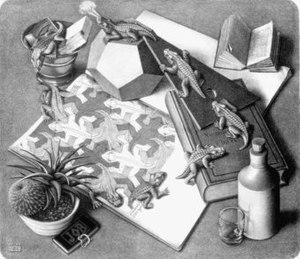
Artist: MC Escher
Title: Reptiles, 1943
Type: Lithograph
Dimensions: 33.4 cm x 38.5 cm
“I think I have never yet done any work with
the aim of symbolizing a particular idea, but the fact that a symbol is
sometimes discovered or remarked upon is valuable for me because it makes it
easier to accept the inexplicable nature of my hobbies, which constantly
preoccupy me.”—MC Escher
Lizards
moving in a circular motion, definitely reminds me of a roundabout. What with
the peculiar lizard puffing out fumes, this gang of reptiles certainly is a
train in motion.
A train. It could mean bullet train, traditional steam train or a train of thought.
A train of thought…
For a person who creates art with such fervour and rigour, who went through intricate planning for his tessellations, I would never read his art work at surface value. It may be just lizards tailing lizards, but perhaps it’s through this depiction of cyclical movement that brings out his notion for art.
He constantly sought for fresh inspiration for his art work, evidently in his trip to Italy in 1922, where he spent all of the spring that year roaming the Italian countryside, drawing landscapes, plants, and even insects. Just like the lizards that are constantly moving, morphing from 3-dimensional to 2-dimensional, explorative and versatile as he was, the lizards mirror his attitude towards art.
Given his spontaneity, perhaps he had studied lizards in close detail before creating Reptiles and thus, he wanted to relate the animate lizards with the inanimate ones through Reptiles by portraying live lizards morphing into their own tessellation.
These interpretations all sum up to a single train of thought. From an idea or an impression that we make of this lithograph, we will start to imagine and draw analogies from our personal lives, what we observed with our five senses, as we try to interpret this art work. Then these imaginations will form thought, and from that single thought, many will follow as it multiplies and morphs. As you think deeper, you realise that it’s hard to trace back to the original raw form of thought. Just like the lizards moving in circles. You don’t know where the start of the cycle is and every time a lizard morphs into a tessellated form of itself, it will never be the same lizard that morphs back to life. Because it could just be any lizard in the vast infinity of its own tessellation; any thought in the vast infinity of our minds, that will continue to form the train and be a part of it.
A woman once rang me up and said, 'Mr. Escher, I am absolutely crazy about your work. In your print -Reptiles- you have given such a striking illustration of reincarnation.' I replied, 'Madam, if that's the way you see it, so be it.'—MC Escher
It’s a pity that we can only view his art work from a third-person’s perspective. But it is his ingenuity that inspires us all, that drives our thoughts to a different dimension, towards his way of thinking, his idea of art. He manoeuvres the train around his beautiful mind, one that sets everybody in awe.
We
are but the passengers of this train, catching glimpses of his lattices of
thoughts. And the driver is none other than MC Escher himself.
Reptiles is realistic and highly defined,
albeit looking slightly grainy under closer examination, which could be due to
the nature of the making of lithographs. There is rhythm, initiated by the
motion of the lizards. The sense movement in the art work is not only indicated
by the lizards, but also by the half-opened book on the top right corner. Its
precarious position sets viewers wondering if the pages will fly. It also
provokes thought since viewers may be curious about what the book is about,
effectively spicing up the art work.
Amidst the
monotonous tones of the art work, Escher was able to work up varying shades of
grey to give depth and tone to both the 2-dimensional and 3-dimensional aspects
of Reptiles. Not only that, the lizards and objects are also proportionate.
This is a trait of Surrealism, which emphasises both realism in depiction of
subject matter and the abstractness of the composition and subject matter. In
reality, lizards can never transform into tessellated lizards and they will never
look like crocodiles. Reptiles is a marriage between impossibility and
reality, absurd happenings put in an ordinary setting, almost like a dream, but
in this case, a nightmare. Monstrous creatures lurking in the midst of
normality, mingling with ordinary objects, changing from on form to another and
back again, which sets an eerie mood, giving an air of mystery, probing viewers
to uncover its underlying meaning. It is indeed every bit a surreal image.
One reference I would
like to make would be Swans. Swans depicts recurring images of well,
swans, forming the infinity symbol, ‘8’ tilted 90 degrees, with the black and
white swans tessellation as they intersect. This is similar to Reptiles as
both involve a sense of movement ad rhythm like the way the lizards actually
move around in circles and morphing into their tessellated form is reflected in
Swans where swans also fly in circular motion and forming a tessellation.
However, the tessellation in Swans actually differ slightly from that in
Reptiles as the tessellation is created serendipitously when the black
and white swans fly pass each other and in a particular angle that Escher
captured, we are able to see a tessellation of black and white swans. The two
flocks of swans, black and white, are flying in their designated directions
forever, similar to the lizards, moving in circular motions forever, abiding by
the law of time—infinity. 
Artist: MC Escher
Title: Swans, 1956
Type: Xylograph
Dimensions: 31.9 cm x 19.8 cm
An interesting
animation of what Reptiles will be like in animation.
No comments:
Post a Comment